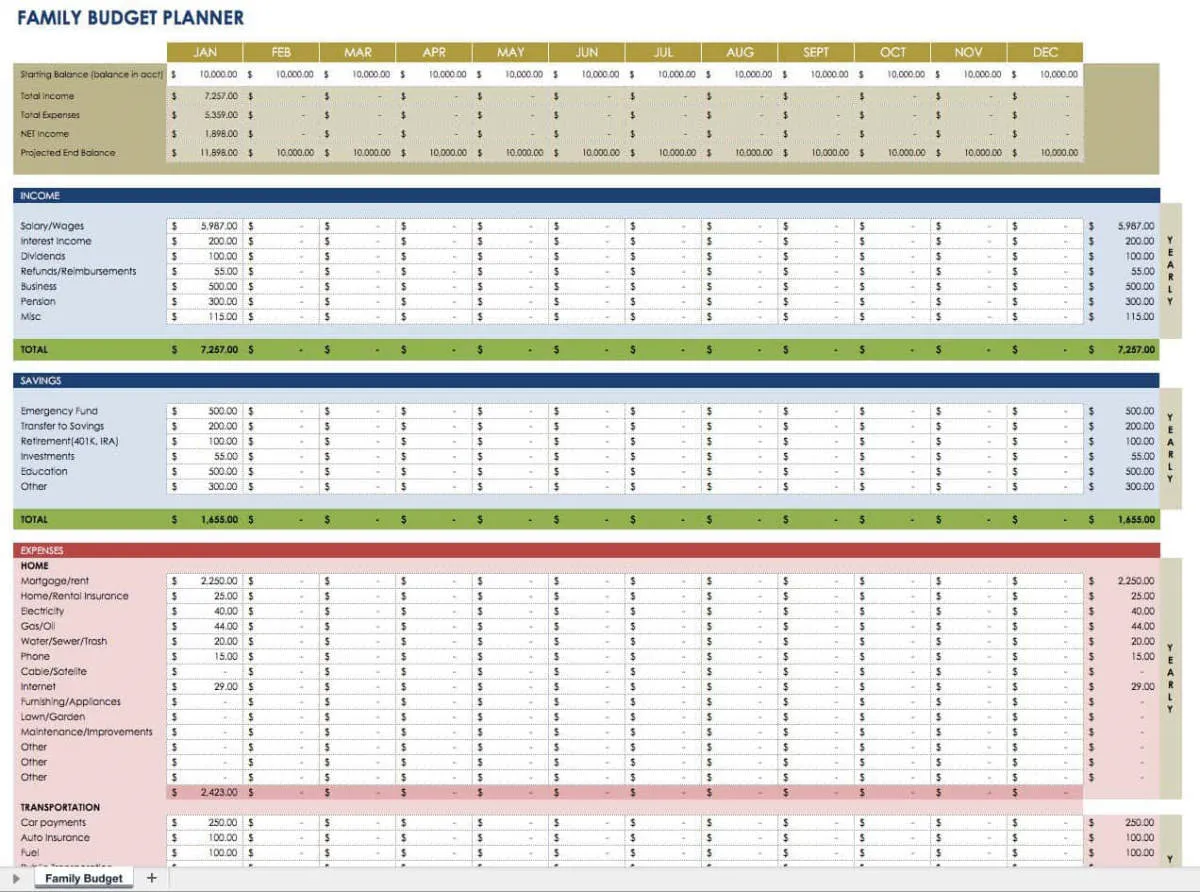Creating a solid financial plan for your family is essential for securing a stable future. Learn the key steps and strategies to effectively manage your finances and ensure long-term financial security for your loved ones.
Importance of a Family Financial Plan
A family financial plan acts as a roadmap guiding you and your loved ones towards financial security and achieving your shared dreams. It provides a structured approach to managing your income, expenses, savings, investments, and protection needs. Here’s why having a family financial plan is crucial:
1. Achieve Financial Goals:
Whether it’s buying a dream home, funding your children’s education, or securing a comfortable retirement, a financial plan outlines the steps to reach these milestones. It helps you prioritize financial goals, allocate resources effectively, and track progress over time.
2. Financial Security & Peace of Mind:
Unexpected events like job loss, medical emergencies, or economic downturns can disrupt financial stability. A well-defined plan equips you with emergency funds, insurance coverage, and other safeguards, providing peace of mind during unforeseen circumstances.
3. Improved Communication & Shared Vision:
Creating a financial plan fosters open communication among family members about financial matters. It ensures everyone is on the same page regarding financial goals, responsibilities, and spending habits. This shared understanding strengthens family bonds and minimizes potential conflicts.
4. Debt Management & Reduction:
A financial plan helps you manage debt effectively. It allows you to analyze current debt obligations, create a repayment strategy, and explore ways to reduce interest payments. By addressing debt proactively, you free up more financial resources for savings and investments.
5. Legacy & Future Generations:
A comprehensive financial plan extends beyond your immediate needs. It considers estate planning, inheritance, and providing for future generations. By thoughtfully addressing these aspects, you ensure your loved ones are taken care of, even in your absence.
Setting Family Financial Goals

Setting financial goals as a family is a crucial step in creating a solid financial plan. It provides a shared vision and encourages collaboration towards achieving financial security.
Start by having open and honest conversations with your family about your financial aspirations. These goals should be specific, measurable, achievable, relevant, and time-bound (SMART).
Here are some common financial goals families may consider:
- Building an emergency fund
- Saving for retirement
- Paying off debt (e.g., credit cards, student loans, mortgage)
- Saving for children’s education
- Purchasing a home
- Investing for the future
- Planning for healthcare expenses
- Creating a legacy (e.g., charitable giving, inheritance)
Prioritize these goals based on your family’s values and circumstances. A goal to become debt-free might take priority over saving for a family vacation. Having clearly defined goals helps you stay motivated and make informed financial decisions.
Creating a Family Budget
A family budget acts as a financial roadmap, guiding your family towards its financial goals. It involves tracking income and expenses, allocating funds for various needs and wants, and ensuring you don’t overspend. Here’s a step-by-step guide:
1. Track Your Income and Expenses
Begin by listing all sources of income, including salaries, wages, bonuses, investment income, etc. Next, diligently track all your expenses. Categorize them into fixed expenses (rent/mortgage, utilities) and variable expenses (groceries, entertainment).
2. Set Financial Goals
Identify your family’s short-term and long-term financial goals. This could include saving for a down payment, children’s education, retirement, or simply building an emergency fund. Having clear goals gives your budget direction.
3. Create a Budgeting Method
Choose a budgeting method that works best for your family. Popular methods include the 50/30/20 rule (50% needs, 30% wants, 20% savings), the envelope system (allocating cash to different spending categories), or zero-based budgeting (allocating every dollar to a specific purpose).
4. Automate Savings and Bill Payments
Automate regular transfers to your savings account to ensure consistent saving. Likewise, set up automatic bill payments to avoid late fees and missed payments.
5. Review and Adjust Regularly
Your family’s financial situation and goals may evolve. Regularly review your budget, at least monthly, to assess its effectiveness. Make adjustments as necessary to stay on track and accommodate any changes.
Remember: Open communication about finances is crucial within a family. Involve all family members in the budgeting process to foster financial literacy and responsibility.
Saving for Family Needs

Saving for family needs is a crucial aspect of a comprehensive financial plan. It provides a safety net for unexpected events and helps you achieve your long-term financial goals. Here’s how to effectively save for your family’s needs:
1. Identify and Prioritize Your Family’s Needs:
Start by listing down your family’s essential needs, both present and future. This could include:
- Emergency Fund: Aim for 3-6 months’ worth of living expenses.
- Housing: Down payment for a house or ongoing rent/mortgage payments.
- Education: Saving for your children’s education expenses.
- Healthcare: Covering medical bills, insurance premiums, and long-term care.
- Retirement: Ensuring a comfortable retirement for you and your spouse.
2. Set Realistic Savings Goals:
Once you’ve identified your family’s needs, determine how much you need to save for each goal. Consider the time frame, potential inflation, and estimated costs. Break down larger goals into smaller, manageable monthly or annual savings targets.
3. Create a Family Budget:
Track your income and expenses to understand your cash flow. Identify areas where you can cut back on unnecessary spending and allocate more towards savings. A well-structured budget is essential for consistent saving.
4. Explore Different Savings Options:
Consider a mix of savings accounts, including:
- High-Yield Savings Accounts: Offer higher interest rates than traditional savings accounts.
- Money Market Accounts: Provide check-writing privileges and variable interest rates.
- Certificates of Deposit (CDs): Offer fixed interest rates for a set period, but early withdrawals may incur penalties.
5. Automate Your Savings:
Set up automatic transfers from your checking account to your designated savings accounts. This ensures consistent saving without relying solely on willpower.
6. Review and Adjust Regularly:
Regularly review your family’s needs, goals, and savings progress. Life circumstances change, so make adjustments to your savings plan accordingly.
Investing for the Future
Investing is a crucial aspect of securing your family’s financial future. It allows you to grow your wealth over time and achieve long-term financial goals, such as funding your children’s education or retiring comfortably.
Here are some key considerations for investing for the future:
1. Determine Your Investment Goals and Time Horizon
Start by identifying your investment objectives. Are you investing for retirement, your children’s education, or a down payment on a house? Your investment goals will shape your investment strategy and the types of investments you choose.
Equally important is your time horizon. This refers to the length of time you plan to invest your money. A longer time horizon allows you to take on more risk, while a shorter time horizon may require more conservative investment choices.
2. Understand Your Risk Tolerance
Risk tolerance refers to your ability to withstand fluctuations in the value of your investments. It’s essential to invest in a way that aligns with your risk appetite. If you’re risk-averse, you might consider more conservative investments like bonds. If you’re comfortable with risk, you could explore equities or real estate.
3. Diversify Your Portfolio
Don’t put all your eggs in one basket. Diversification involves spreading your investments across different asset classes, such as stocks, bonds, and real estate. It helps mitigate risk by ensuring that if one investment performs poorly, others can cushion the impact.
4. Consider Tax-Advantaged Accounts
Explore tax-advantaged accounts like 401(k)s or IRAs. These accounts offer tax benefits that can help your investments grow more quickly over time. Contributing to these accounts can be a smart way to save for retirement or other long-term goals.
5. Review and Adjust Regularly
Financial planning is not a one-time task. It’s crucial to review your investment portfolio regularly, at least annually, and make adjustments as needed. Life events, market conditions, and changes in your financial goals may require you to re-evaluate your investment strategy.
Managing Family Debt

Debt is a common financial challenge for many families. It can stem from various sources, such as mortgages, student loans, credit card purchases, or unexpected expenses. While some debt can be manageable, excessive or high-interest debt can put a strain on your family’s financial well-being. Therefore, managing debt effectively is crucial for achieving your financial goals.
Creating a Debt Management Plan
The first step towards effectively managing family debt is to create a comprehensive debt management plan. This plan will serve as a roadmap for tackling your debt and regaining control over your finances.
- List all debts: Begin by creating a detailed list of all your debts. Include the creditor’s name, total outstanding balance, interest rate, and minimum monthly payment for each debt.
- Prioritize debts: Once you have a clear picture of your debts, prioritize them based on interest rates and urgency. High-interest debts, such as credit cards, should be prioritized as they accumulate debt quickly.
- Explore debt consolidation: If you have multiple debts with high-interest rates, consider debt consolidation. This involves taking out a new loan with a lower interest rate to pay off your existing debts. Consolidating your debts into one monthly payment can simplify debt management and potentially save money on interest charges.
- Negotiate with creditors: Don’t hesitate to reach out to your creditors to negotiate lower interest rates or monthly payments. Explain your financial situation and inquire about hardship programs or temporary forbearance options that might be available.
- Seek professional guidance: If you are struggling to manage your debt or create a plan, consider seeking help from a financial advisor. A qualified advisor can provide personalized guidance based on your circumstances and help you develop a solid debt management strategy.
Developing Healthy Debt Management Habits
Managing debt effectively is an ongoing process that requires discipline and consistent effort. By adopting healthy financial habits, you can prevent future debt accumulation and stay on track with your financial goals.
- Create a realistic budget: Track your income and expenses meticulously to gain a clear understanding of your cash flow. Identify areas where you can cut back on spending and allocate more funds towards debt repayment.
- Build an emergency fund: Unexpected events, such as job loss or medical bills, can derail even the most carefully crafted financial plans. Establish an emergency fund to cover three to six months of living expenses. Having this financial cushion will help you avoid going into debt when unforeseen circumstances arise.
- Live within your means: Avoid overspending and resist the temptation to accumulate unnecessary debt. Differentiate between your needs and wants, and prioritize spending on essential items.
- Review your progress regularly: Periodically review your debt management plan and make adjustments as needed. Track your progress, celebrate milestones, and stay motivated throughout the debt repayment journey.
Planning for Major Life Events
Life is full of unexpected twists and turns, and while we can’t predict the future, we can certainly prepare for it financially. Major life events – both positive and challenging – will inevitably impact your family’s financial landscape. Incorporating these milestones into your financial plan is crucial for maintaining stability and achieving your long-term goals.
Here are some key life events to consider:
1. Marriage:
Tying the knot often means combining finances. This presents an opportunity to align your financial goals, discuss debt management strategies, and potentially explore joint investment accounts.
2. Buying a Home:
This significant purchase requires careful saving for a down payment, understanding mortgage options, and budgeting for ongoing expenses like property taxes and maintenance.
3. Having Children:
From childbirth costs to education expenses, raising a family demands considerable financial planning. Consider setting up a 529 college savings plan and factoring in childcare costs.
4. Career Changes & Job Loss:
Whether you’re pursuing a new opportunity or facing unexpected unemployment, having an emergency fund and being adaptable with your budget can provide a safety net during transitions.
5. Caring for Aging Parents:
Supporting aging parents might involve medical expenses, home care, or even adjustments to your living situation. Discuss long-term care options and consider how this responsibility could impact your finances.
6. Retirement:
Transitioning to retirement requires careful planning to ensure your savings will support your lifestyle. Consider factors like healthcare costs, potential travel plans, and whether you plan to work part-time.
Tips for Planning:
- Regularly Review & Adjust: Life throws curveballs. Regularly review your financial plan and make adjustments as your circumstances change.
- Seek Professional Advice: Consider consulting with a financial advisor who can provide personalized guidance based on your specific goals and life stages.
Reviewing and Updating Your Plan

Creating a financial plan isn’t a “set it and forget it” kind of task. Life is constantly changing, and so are your financial needs and goals. That’s why it’s crucial to regularly review and update your plan.
How Often Should You Review?
A good rule of thumb is to review your financial plan at least once a year. However, certain life events might require more frequent reviews. These events could include:
- Marriage or divorce
- Birth or adoption of a child
- Job loss or change in income
- Significant investment gains or losses
- Receiving an inheritance
- Major health issues
What to Consider During Your Review:
During your review, consider the following aspects of your financial plan:
- Goals: Have your short-term or long-term goals changed? Do you need to adjust your savings rate or investment strategy to stay on track?
- Budget: Review your income and expenses. Have there been significant changes? Are you still living within your means?
- Debt: Assess your progress on paying down debt. Do you need to adjust your repayment strategy?
- Investments: Evaluate your investment performance. Is your asset allocation still appropriate for your risk tolerance and time horizon?
- Insurance: Review your insurance policies (life, health, disability, etc.) to ensure you have adequate coverage for your current needs.
- Estate Planning: Make sure your will, trust, and beneficiary designations are up-to-date.
Conclusion
In conclusion, creating a financial plan for your family is crucial for ensuring financial stability and security. By setting clear goals, budgeting wisely, and continuously reviewing and adjusting the plan, you can safeguard your family’s future financial well-being.

